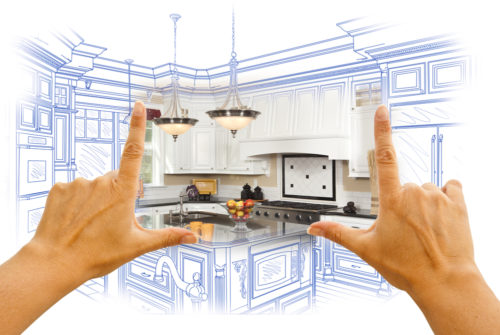Whether you’re a new homeowner, or the value of your home has decreased and left you without equity, there may be upgrades you wish to make to improve your home without a home equity loan or a home equity line of credit. Depending on the renovations you’re interested in making, you may not be able to afford significant repairs or upgrades right after purchasing a home. However, there are a variety of home improvement loans you can use to finance home renovations and repairs, even without equity.
Table of Contents
Unsecured Home Improvement Loans
Title 1 Loans
Homeowners can apply for Title 1 loans to fund a variety of small or large renovations needed in their home, These loans are available for up to $25,000, and can be used for any necessary repair or renovation, although they can not be used for luxury upgrades, such as installing a pool or hot tub. However, any loan over $7,500 requires collateral, either in the form of the mortgage, or deed of the trust on the property.
Even if you do have equity, some homeowners seek out home improvement loans with no equity in order to avoid using their homes as collateral; even if you sell the home, the loan is attached to you, so you can choose when you want to pay off the loan. Under some circumstances, these loan options are better for individuals who are seeking to receive the loan quickly. Typically, there are no closing costs with a Title 1 Home Improvement Loan, and you are able to receive the loan more quickly than if you were using home equity.
Although the loan’s interest rates are higher than if you were using equity, you are also able to pay off the loan on your terms. While you can get a loan term of up to 20 years, you can also pay off the loan early without incurring prepayment penalty costs, which can save you money on interest in the long run. However, the penalties vary from lender to lender, so you will want to double check the terms of your loan as you shop around. Keep in mind that you are unable to deduct interest on taxes for these kind of loans, unlike standard home equity loans.
Personal Loans for Home Improvement
Another option is a personal home improvement loan. While these may have more stringent credit requirements, higher interest rates and lower maximum loans, they offer a lot more flexibility than home equity loans. These loans can basically be used for any purpose, including luxury upgrades like a pool or hot tub, all without putting your home on the line. These loans are an attractive option for people with good credit, as the application process is quick, easy, and can often be approved within the same day. Personal home improvement loans typically have a fixed interest rate, shorter terms and usually offer a standard monthly payment over the life of the loan.
Home Improvement Loans
Home improvement loans are sometimes advertised by lenders as a separate product, but they really amount to being a personal loan. However, the terms and requirements may be more lax as the the lender expects you to spend the loan on renovations, repairs or upgrades.
Contractor Financing
Some specialized contractors may offer their own financing with no equity requirements, however this may only be an option for certain renovations and repairs; most commonly, roofing, flooring and heating and cooling systems. This type of financing may have higher interest rates than personal loans, and can become complicated if you don’t like the contractor’s end product, as you can’t withhold payment to get them to fix what you don’t like.
Using Credit Cards to Pay for Home Improvements
If you have a credit card with a high limit, or are in the market for a credit card to fund your home improvements, there are a few things to consider. Due to the high costs of home renovations and the high interest rates of credit cards, you should only really use credit cards to fund home improvements if you can get a low or no interest card for 12-18 months. If you are successful, you’ll want to make sure you pay off the card before the interest starts to build. This can be a good option if you have a high credit score, are accumulating points and if the credit limit is enough to cover the cost of your renovations.
Financing for Green, Sustainable, or Energy-Efficient Home Improvements
If the renovations you’re hoping to make fall under the energy-efficient category, you may be eligible for alternative loans, grants or federal financing to make sustainable upgrades.
Energy Efficient Mortgages
Energy efficient mortgages (EEM) are eligible through the Federal Housing Administration and recognized by the federal government. This loan rolls into a primary mortgage and you can get it when you get your first home mortgage if you know those are changes you want to make to the home. This loan is for energy-saving upgrades, such as a new heating, ventilation and/or air conditioning system, as older models waste a lot of energy. The limit to these loans is tied to the expected value of the home after the improvements are made.
State Programs for Green Home Improvements
There are some grants and loans available on a state-to-state basis for people hoping to make energy-efficient upgrades to their home, such as installing renewable energy or purchasing green appliances. These can come as loans or in the form of a tax return for the purchase. To find local financing or incentives, look at your state’s housing finance agency website, as well as the U.S. Department of Energy and the Department of Housing and Urban Development (HUD) for more information about programs available in your state.
There are several options available for homeowners in need of financing for renovations and repairs that do not require using home equity. Although there are many financing options, it’s always a good idea to save up and pay for your home improvements with saved funds whenever you can to avoid putting yourself into more debt. Home equity is an appealing option due to low interest rates and the potential of increasing your home’s value to balance out the equity, but unsecured loans have benefits like shorter terms, which can end up cutting the interest you pay. It’s also never a bad idea to avoid using your home as collateral, but the route you take will ultimately depend on your circumstances and the loan factors that will work best for your specific situation.
Image Source: https://depositphotos.com/





